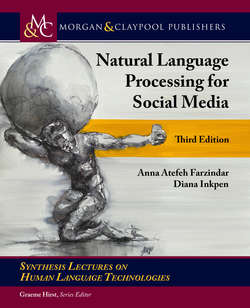Читать книгу Natural Language Processing for Social Media - Diana Inkpen - Страница 9
На сайте Литреса книга снята с продажи.
ОглавлениеList of Figures
1.1 Social networks ranked by the number of active users as of January 2014 (in millions) provided by Statista
1.2 Number of monthly active Facebook users from the third quarter of 2008 to the first quarter of 2014 (in millions) provided by Statista
1.3 Number of LinkedIn members from the first quarter of 2009 to the first quarter of 2014 (in millions) provided by Statista
1.4 A framework for semantic analysis in social media, where NLP tools transform the data into intelligence
2.1 Methodology for tweet normalization. The dotted horizontal line separates the two steps (detecting the text to be normalized and applying normalization rules) [Akhtar et al., 2015]
2.2 Taxonomy of normalization edits [Baldwin and Li, 2015]
2.3 Arabic dialects distribution and variation across Asia and Africa [Sadat et al., 2014a]
2.4 Division of Arabic dialects in six groups/divisions [Sadat et al., 2014a]
2.5 Accuracies on the character-based n-gram Markov language models for 18 countries [Sadat et al., 2014a]
2.6 Accuracies on the character-based n-gram Markov language models for the six divisions/groups [Sadat et al., 2014a]
2.7 Accuracies on the character-based n-gram Naïve Bayes classifiers for 18 countries [Sadat et al., 2014a]
2.8 Accuracies on the character-based n-gram Naïve Bayes classifiers for the six divisions/groups [Sadat et al., 2014a]
3.1 Example of a pair of tweets extracted from the bilingual feed pair Health Canada/Santé Canada, after tokenization
3.2 An original tweet with hashtags in its three possible regions
4.1 Examples of annotated social media posts discussing ADRs [Nikfarjam et al., 2015]
4.2 The DeepHealthMiner neural net architecture [Nikfarjam, 2016]
4.3 SVM-based text mining procedure for impact management [Schniederjans et al., 2013]
A.1 TRANSLI Social Media Analytics and monitoring module architecture
A.2 TRANSLI user interface for event creation module
A.3 TRANSLI user interface for event browsing module
A.4 TRANSLI user interface to present an event. Components are identified with their IDs
